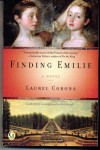Finding Emilie by Laurel Corona, Gallery Books, 2011, 427 pages plus reading guide and conversation with author, $15.
By Donald H. Harrison

SAN DIEGO – Questions often arise about biblical passages, which seem to skip a lot of material. To fill in those blanks, rabbis over the centuries have written explanatory stories known as medrashim. Some may draw on true material, others may be fanciful, but eventually they become incorporated into Jewish tradition.
Laurel Corona, a member of our community who is a professor of Humanities at San Diego City College, is doing much the same with history and with classic literature in order to fill in the blanks about women’s experiences in various epics and epochs.
In The Four Seasons, we learned of the women of Vivaldi’s time. In Penelope’s Daughter, Corona created and followed the life of another child of Odysseus and Penelope. Now, in Finding Emilie, she takes the real-life Gabrielle-Emilie le Tonnelier de Breteuil, Marquise du Châtelet, and imagines what would have happened if her infant daughter had lived beyond two years of age.
 Emilie, though married to the Marquis de Châtelet, was a scientist in an era when higher learning was considered unseemly for women. She also was quite openly—and with the consent of her husband—the mistress of the great literary figure, Voltaire, who in return helped to expand the Châtelet chateau. To say the least, Emilie was an unusual woman for her time, one who would stand out even in our era. In imagining the life of Stanislas-Adelaide, her daughter, who was known to her friends and family as “Lili,” Corona was free to tell a “like-mother-like-daughter story” that introduces us to the constraints and intrigues which shaped the lives of pre-French Revolution nobility—including those free-thinkers who allowed their thoughts to contradict both church and crown.
Emilie, though married to the Marquis de Châtelet, was a scientist in an era when higher learning was considered unseemly for women. She also was quite openly—and with the consent of her husband—the mistress of the great literary figure, Voltaire, who in return helped to expand the Châtelet chateau. To say the least, Emilie was an unusual woman for her time, one who would stand out even in our era. In imagining the life of Stanislas-Adelaide, her daughter, who was known to her friends and family as “Lili,” Corona was free to tell a “like-mother-like-daughter story” that introduces us to the constraints and intrigues which shaped the lives of pre-French Revolution nobility—including those free-thinkers who allowed their thoughts to contradict both church and crown.
Lili, who had been kept in the dark about her parentage, is the character who is “Finding Emilie,” while we, as readers, can’t help but be fascinated by how similar her spirit is to her mother’s—perhaps too similar, as, at times, it is difficult to differentiate them. In telling the story, Corona draws portraits of two sets of perhaps-idealized female relationships – that of best friends and near sisters, Lili and Delphine, and those of mother Julie de Bercy, daughter Delphine and adopted daughter Lili. For most of the novel, boys and men are either romanticized notions or lustful cads.
One particularly well-done section depicted the terror with which Lili and Delphine prepare for their presentation to the queen of France—involving curtsying in a “reverence” to the queen, and then straightening up without losing one’s balance, an ordeal made all the more difficult by the panniers (side hoops) that women who attended the court then favored.
Corona utilizes several literary devices in this work. These include the juxtaposition of Emilie’s and Lili’s stories; letters between characters in the novel, and a satiric collection of short stories written by Lili, commenting on some of the absurdities of French high society.
Although the work is fiction, Corona achieves her goal of entertaining and educating readers about the lives that women led in 18th Century France. I have only one quibble—and perhaps it is extraneous to the text. Voltaire, unfortunately, was considered by many to be quite an anti-Semite, although he was defended against this charge by others. I’d have welcomed Corona weighing in on this controversy, especially as to the role that Emilie de Châtelet might have played in moderating, fueling, or ignoring such a flaw.
*
Harrison is editor of San Diego Jewish World. He may be contacted at donald.harrison@sdjewishworld.colm